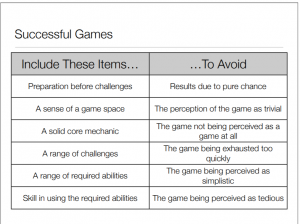There are many different games out there and players naturally like some better than others. So what are the elements of a game that make it good? What are the elements of a game that make it a bad game?
I like games that have an element of increased challenge. Not too easy and not too hard, plus you have a feeling of progression throughout the game. The controls of the game should be comfortable. There should be a good story with a sense of adventure and fun characters. If you are not into the story or the characters the game could become tedious after awhile. I like games that have checkpoints or save points. This fits in with the sense of accomplishment, if I have played for an hour but then lose a life and have to start the entire game over again that would be frustrating. The game should be fun – if I am not getting any enjoyment out of playing what is the point? Also depending on the context of the game I like the idea of relate-able elements or nostalgia. Playing Super Mario Odyssey I really enjoy the components that draw back to the feel of the original Super Mario Bros.
Naturally these are somewhat subjective and different people enjoy different things in their games. However, there are some components that seem to define a good game versus a bad game. Dr. Ruben Puentedura (the S.A.M.R. guy) published a podcast about this very topic in which he discussed his research findings about what makes a game successful and what makes a bad game.
Super Mario 64 for the Nintendo 64 would be an example of a good game. It contains:
– Memorable characters
– Story that you are introduced to at the beginning of the game
– Controls – the game gives you the info you need to navigate through the game
– Tutorial elements to teach you how to play the game and learn new skills
– The overall challenge of the game is explained to the player
Superman 64 for the Nintendo 64 is an example of a BAD game.
– The Demo on the start screen shows you mistakes in gameplay and the character gets stuck at one point
– What is the story? There is one, but you have to go out of your way to click on the menu to find it
– Repeated stages of rings, some of which later in the game can last up to 10 minutes. Very repetitive
– Lack of variety
– There are mini games at the end of each ring stage, but if you are unsucessful, you have to start the entire stage over again
– Poor combat for enemy battles
This knowledge is very helpful to have as I begin to construct my own game.
Dr. Puentedura has done a series of podcasts on educational gaming called “Game and Learn” You can listen to them via iTunes here. http://hippasus.com/resources/gameandlearn/slides/2_WhatIsAGoodGame.pdf
The Tech Integrator





